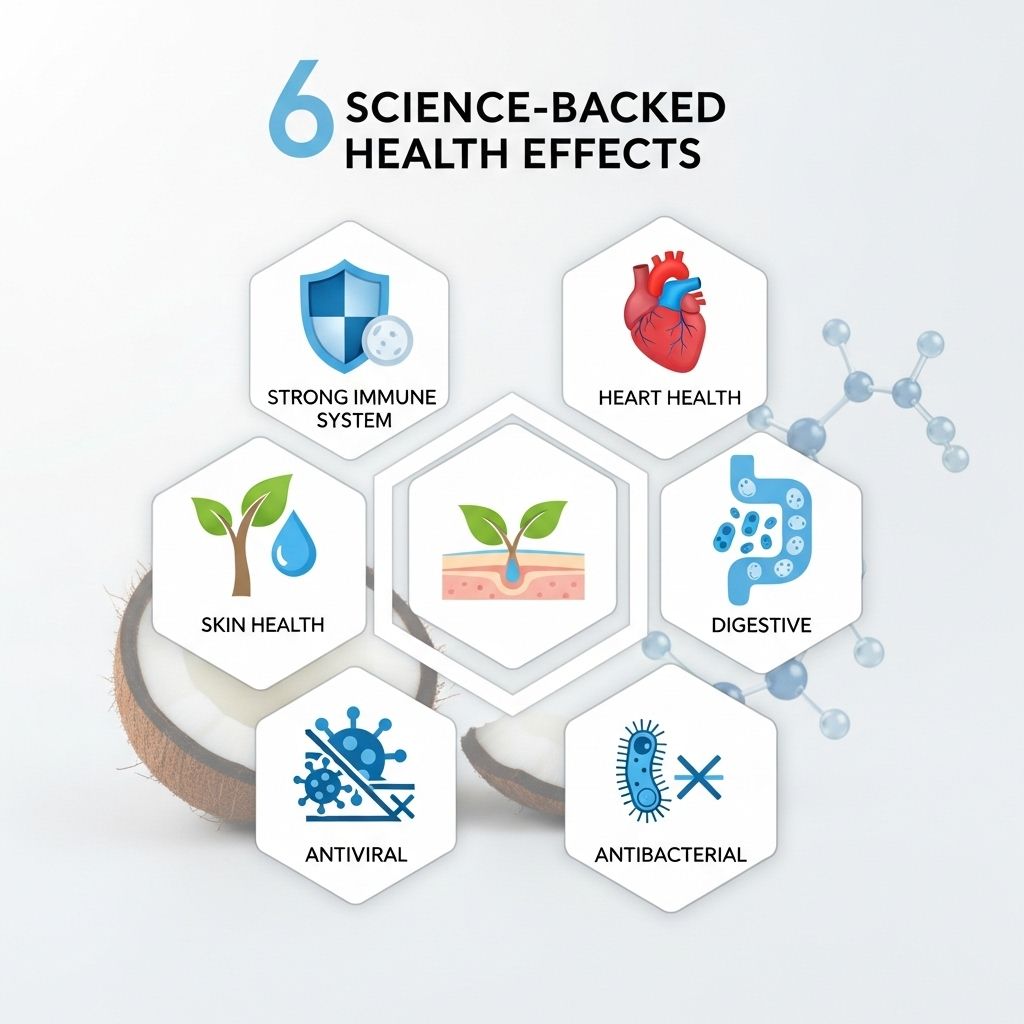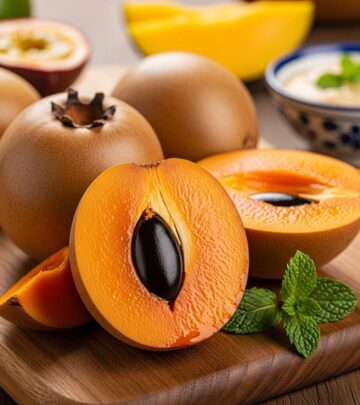Monolaurin Benefits: Uses, Properties, Side Effects, and FAQs
Disrupts harmful microbes and strengthens immune defenses for balanced well-being.

Monolaurin Benefits: Comprehensive Guide
Monolaurin, also known as glycerol monolaurate, is a natural compound formed from lauric acid, predominantly found in coconut oil and breast milk. Gaining popularity as a dietary supplement, monolaurin offers a wide array of health benefits on account of its antimicrobial, antiviral, and immune-boosting properties. This article provides an in-depth look at the science, potential uses, safety, and frequently asked questions about monolaurin.
What is Monolaurin?
Monolaurin is a monoacylglycerol derived by combining lauric acid with glycerol. Lauric acid itself is a medium-chain fatty acid found abundantly in coconut oil, palm kernel oil, and human breast milk. When lauric acid is digested and metabolized in the body, some of it converts into monolaurin, which is believed to be far more potent in its biological activity.
- Natural sources: Coconut oil, breast milk, palm kernel oil
- Alternative names: Glycerol monolaurate, Glyceryl laurate
- Forms available: Capsules, granules, powder supplements
Monolaurin’s Core Health Benefits
While research is ongoing, a growing body of evidence suggests that monolaurin may offer the following health benefits:
1. Antibacterial Properties
Monolaurin has demonstrated effectiveness against a wide spectrum of bacteria. These effects are particularly pronounced against gram-positive bacteria (like Staphylococcus aureus), some gram-negative bacteria (such as E. coli), and even antibiotic-resistant strains such as MRSA.
- Disrupts bacterial cell membranes, killing the bacteria
- Inhibits growth and toxin production of dangerous pathogens like Clostridium botulinum and Bacillus cereus
- Reduces risk of skin and soft tissue infections
- No significant development of bacterial resistance observed with monolaurin use
Key Study: Laboratory (in vitro) research found that monolaurin inhibits Staphylococcus aureus and reduces toxin production, indicating potential for use against staph infections.
2. Antiviral Activity
Monolaurin has shown strong activity against several enveloped viruses in laboratory studies. It works by disrupting the lipid membrane surrounding these viruses, rendering them inactive and unable to infect host cells.
- Effective against viruses such as influenza, herpes simplex (HSV-1 and HSV-2), Epstein-Barr virus, HIV, measles, cytomegalovirus, and certain coronaviruses
- Prevents attachment and replication of viruses in host tissues
- May potentially shorten colds, flu, and other viral illnesses
Note: Most findings are currently limited to laboratory (in vitro) or animal studies. Clinical studies in humans are still needed.
3. Antifungal and Other Antimicrobial Actions
Monolaurin’s benefits extend to antifungal properties, combating pathogens like Candida albicans, which can cause yeast infections and systemic candidiasis. It is also considered active against some protozoal infections.
- Helps manage common conditions such as ringworm, athlete’s foot, and oral thrush
- May assist in balancing gut microbiota and preventing overgrowth of harmful organisms
4. Immune System Enhancement
Monolaurin supports the immune system’s response to pathogens by:
- Stimulating and attracting white blood cells (leukocytes) to sites of infection
- Controlling the production of inflammatory cytokines (messenger proteins involved in immune response)
- Reducing the impact of pro-inflammatory markers, aiding in recovery from infections and inflammation-driven conditions
5. Metabolic & Systemic Benefits
Emerging evidence suggests that monolaurin may offer additional health benefits:
- Anti-diabetic effects: Helps regulate blood sugar and insulin levels, potentially lowering risk of diabetes
- Anti-obesity mechanism: Modulates fat metabolism and gut microbiota, preventing excessive weight gain
- Antioxidant actions: Combats oxidative stress at the cellular level
- Anti-atherogenic properties: Supports heart health by inhibiting atherosclerosis (artery hardening)
6. Additional Potential Uses
- Relief and prevention of cold sores and shingles (due to herpes simplex and varicella-zoster virus)
- Management of chronic fatigue syndrome (when relating to underlying infections)
- May help those with weakened or compromised immune systems
How Monolaurin Works: Mechanisms of Action
Monolaurin’s multifaceted mechanisms contribute to its broad antimicrobial effects:
- Disruption of pathogen membranes: Integrates into and disorganizes lipid bilayers (membranes) of bacteria, viruses, and fungi, resulting in cell death.
- Inhibition of toxin and virulence factor production: Prevents pathogens from producing harmful substances.
- Impairment of viral assembly: Interferes with the processes needed for viruses to mature and replicate.
- Modulation of immune response: Dampens harmful inflammation while promoting protective immune cell activity.
Monolaurin Supplementation: Dosage, Forms, and Usage
Dietary monolaurin supplementation is available in various forms, including capsules, softgels, and granules. Natural dietary sources (coconut oil) do contain lauric acid, but not enough to achieve the doses used in most studies – supplementation is considered necessary for therapeutic benefits.
| Form | Typical Dose Range | Notes |
|---|---|---|
| Capsules / Softgels | 600 mg – 3 g daily | Divided doses with meals |
| Granules / Pellets | 1/4 – 1 teaspoon up to 2–3 times daily | Adjust dose based on needs |
| Powder | Up to 3 g per day | Mix into food or beverage |
Note: There are no official standard dosages for monolaurin due to limited clinical data. Always consult with a healthcare professional before starting supplementation.
Safety, Side Effects, and Precautions
Monolaurin is considered safe for the majority of people when used orally as a dietary supplement. Most research and anecdotal evidence indicates very few side effects, and it does not appear to disrupt the balance of beneficial intestinal bacteria or contribute to antibiotic resistance.
- Commonly reported side effects: Mild digestive discomfort (nausea, loose stools), especially when starting or at higher doses
- Herxheimer reaction: Temporary flu-like symptoms (headache, body aches, fatigue) can occur if monolaurin rapidly kills off large numbers of microorganisms. This is usually short-lived and resolves by reducing the dose or increasing water intake
- Allergies: Rare; people with coconut allergies should exercise caution
Precautions:
- Pregnancy & Breastfeeding: Lacking sufficient research; consult a healthcare provider before using
- Chronic illness or medication use: Discuss with your physician to prevent potential interactions
- Children: No established safety data for pediatric use outside of doses naturally occurring in breast milk
Nutritional and Food Uses
Besides supplements, monolaurin is used in the food industry as a preservative due to its ability to inhibit microbial growth and extend shelf life of processed foods. It is also found in some cosmetics and personal care products for its antimicrobial actions.
Summary Table: Monolaurin At A Glance
| Feature | Description |
|---|---|
| Natural Sources | Coconut oil, breast milk, palm kernel oil |
| Main Benefits | Antibacterial, antiviral, antifungal, immune modulating |
| Common Uses | Support against infections (cold, flu, staph, herpes, candida), immune support |
| Supplement Forms | Capsules, granules, powder |
| Side Effects | Rare; potential for mild digestive discomfort or temporary detox symptoms |
Scientific Research and Limitations
Most of the evidence for monolaurin’s benefits comes from in vitro and animal studies. While these results are promising, well-designed clinical trials in humans are lacking. Researchers continue to explore its effects, optimal dosages, and long-term safety.
- Antibacterial/antiviral: Widely supported in laboratory studies
- Human studies: Very limited, so routine medical use remains investigational
- GRAS status: Monolaurin is generally recognized as safe when used as a food additive
Frequently Asked Questions (FAQs) about Monolaurin
Q: Can I get enough therapeutic monolaurin from coconut oil alone?
A: No. While coconut oil is a good source of lauric acid, only a small amount is converted into monolaurin in the body. Supplements provide much higher and more consistent amounts for therapeutic purposes.
Q: Is monolaurin safe to take every day?
A: Monolaurin is generally considered safe for most adults in recommended amounts. For individuals with medical conditions, pregnant or breastfeeding women, and children, it is best to consult a healthcare provider before use.
Q: Does monolaurin kill beneficial gut bacteria?
A: Evidence suggests that monolaurin selectively targets harmful microbes and does not adversely affect beneficial intestinal flora.
Q: Can monolaurin help with antibiotic-resistant infections?
A: Laboratory studies indicate strong activity against antibiotic-resistant bacteria including MRSA. However, human trials are needed to confirm clinical effectiveness.
Q: Are there drug interactions to be aware of?
A: There are no confirmed reports of drug interactions. However, it is recommended to consult a healthcare provider if you are on medication or have a chronic health condition.
Key Takeaways
- Monolaurin is a versatile supplement with potent antimicrobial, antiviral, and immune-supportive effects, primarily backed by laboratory research.
- It is derived from natural sources such as coconut oil and breast milk, but supplements provide higher doses for health applications.
- Generally safe, with rare side effects, but individuals should consult healthcare professionals before starting supplementation, especially when pregnant, breastfeeding, or managing a chronic condition.
- Research is ongoing—while promising, more human clinical trials are needed to confirm many of the proposed benefits.
References
- Bioactive monolaurin as an antimicrobial and its potential to improve human health
- Monolaurin – What is it and what are its benefits?
- Monolaurin: Benefits, uses, forms, and side effects
- The Clinical Use of Monolaurin as a Dietary Supplement
- Monolaurin – Uses, Side Effects, and More – WebMD
References
- https://www.myfoodresearch.com/uploads/8/4/8/5/84855864/_67__fr-2020-324_subroto.pdf
- https://martinswellness.com/blog/post/monolaurin-benefits
- https://www.medicalnewstoday.com/articles/319590
- https://pmc.ncbi.nlm.nih.gov/articles/PMC7486475/
- https://www.webmd.com/vitamins/ai/ingredientmono-1149/monolaurin
- https://www.frontiersin.org/journals/veterinary-science/articles/10.3389/fvets.2023.980187/full
- https://www.healthline.com/health/monolaurin
Read full bio of Sneha Tete












